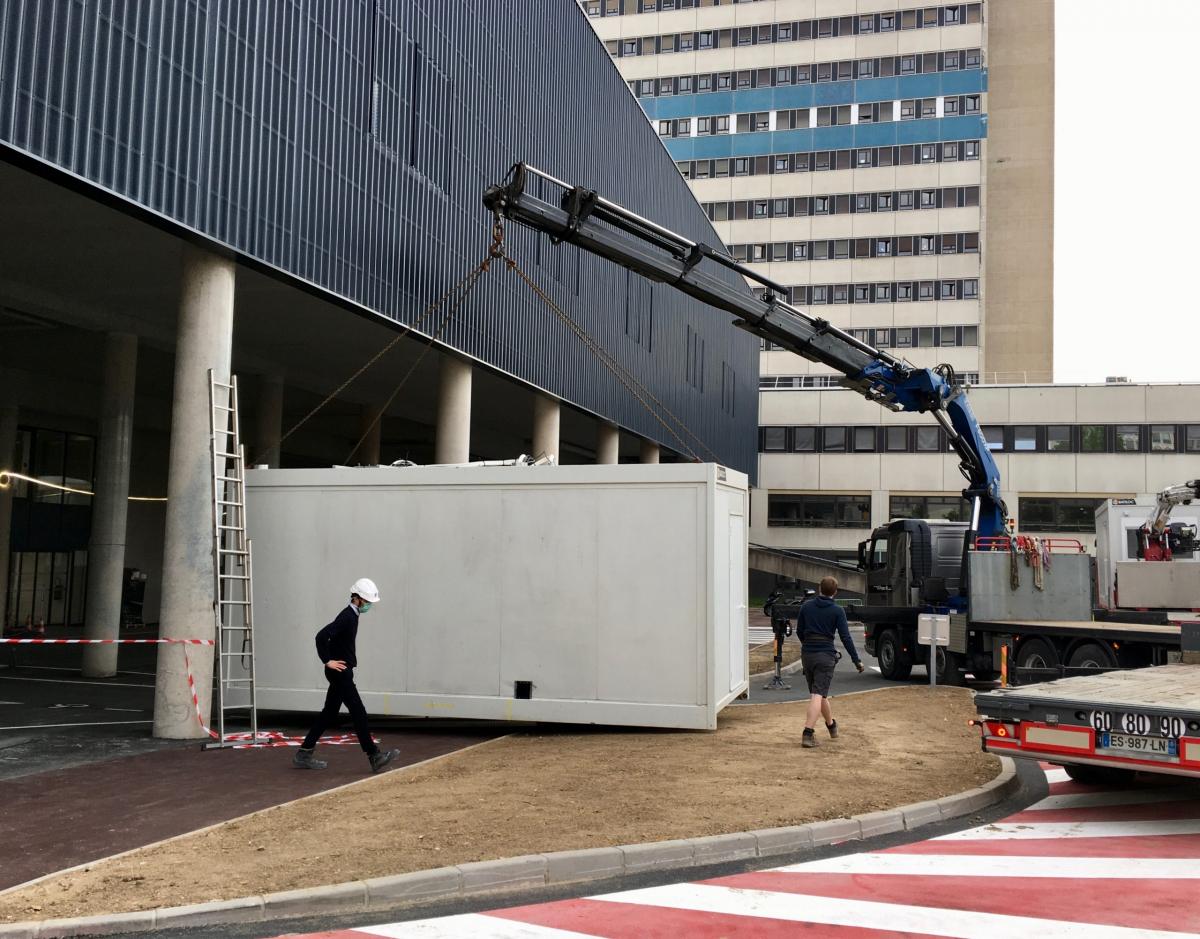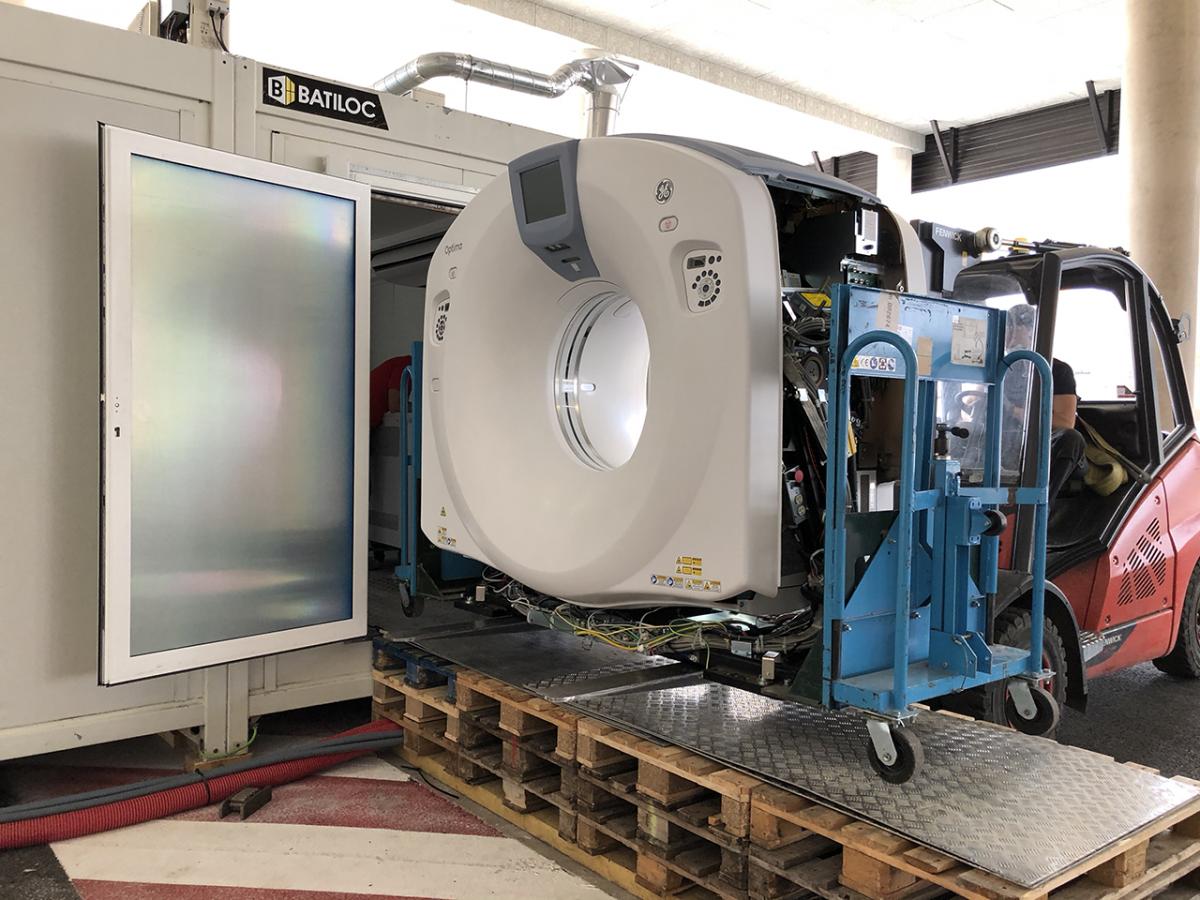
A cut-away view of the two cabins that compose the "CT-in-a-box" solution from GE to rapidly deploy CT scanners at hospitals amid a COVID surge. The CT room is completely separate from the control room to aid in sanitation and keeping technologists away from COVID patients. Image by GE Healthcare.
December 1, 2020 — As hospitals see an influx of COVID-19 (SARS-CoV-2) patients, many are looking for ways to rapidly expand their radiology imaging capabilities. Large computed tomography (CT) system vendors offer semi-truck trailer configurations, and some began offering CT systems packaged neatly inside cargo shipping containers so they can be installed as semi-permanent buildings.
When the demand for additional imaging capability was needed during the spring 2020 surge of novel coronavirus in Paris, France, GE Healthcare created a prefabricated cabin to house a CT system outside the entrance of the giant Henri-Mondor Hospital in Créteil, a commune in the southeastern suburbs of Paris. Nestled inside the specially designed 36-square-meter module has been dubbed “CT in a box” by the GE Healthcare engineers who invented it.
The extra machine helped Hospital Henri-Mondor in assessing disease progression and complications in COVID-19 patients while also smoothing patient flow across the facility. That is because the module is entirely dedicated to COVID-19 patients, explained François Meignan, a project manager at GE Healthcare who designed the project. “It’s not just about patient numbers — it creates a specific flow for them.”
GE first deployed the technology in China and the United Arab Emirates. “At the beginning of the outbreak, China’s clinicians in remote or pop-up hospitals quickly called for the precise images CT scans provide to help them spot complications earlier,” said Kieran Murphy, GE Healthcare CEO, wrote in an opinion piece published in Barron’s. “To address this need, our engineers quickly developed CT-in-a-box, an easy to install modular machine that captures the same robust imagery of traditionally installed CT scanners. Learning from our experience there, GE Healthcare teams in France developed a similar solution to address the urgent need for additional imaging capacity — and specifically adapted it to the needs of clinicians caring for COVID-19 patients.”
 The French hospital already had plans to beef up its intensive care unit (ICU) bed capacity several months before the coronavirus pandemic, but the rapid spread of the infection accelerated its plans. In late March, hospital authorities decided to nearly double the facility’s ICU capacity from 90 to 175 beds. “Our three CTs were already fully busy, [so we thought] how can we create a fourth one?” said Professor Alain Luciani, radiologist and medical head of Academic and Medical Department FIxIT. “We turned to GE Healthcare and said ‘OK, how can you help us?’”
The French hospital already had plans to beef up its intensive care unit (ICU) bed capacity several months before the coronavirus pandemic, but the rapid spread of the infection accelerated its plans. In late March, hospital authorities decided to nearly double the facility’s ICU capacity from 90 to 175 beds. “Our three CTs were already fully busy, [so we thought] how can we create a fourth one?” said Professor Alain Luciani, radiologist and medical head of Academic and Medical Department FIxIT. “We turned to GE Healthcare and said ‘OK, how can you help us?’”
Brainstorming began immediately. “The opening of the new building was already planned for April 9, so we had to find a solution — concept and build — in two weeks,” explains Meignan, a project manager who works at GE Healthcare in the north of France. “They [the hospital] wanted an easy-to-install solution, fast in concept, and fast in building, so we worked on drawings to find a solution,” said Meignan.
Designing a CT Room in a Box
The team soon discovered that designing this CT in a box required some out-of-the-box thinking. The sticking point was not fitting the CT machine itself in a trailer, but replicating the safe, controlled and easily accessible environment of a hospital CT room.
The small dose of radiation emitted by a CT scan may be low-risk to the patient, but imaging technicians repeat the procedure several times per day. That is why CTs always have lead-shielded walls and thick windows between the exam room and control room, where technicians and clinicians can observe the patient and perform the imaging process. It’s also why the exam room and control room each have their own doors.
CT scan rooms also use sophisticated heating, ventilation and air conditioning (HVAC) systems to maintain a constant temperature of around 72 degrees Fahrenheit. The exam room is prone to increasing temperatures because the gantry’s electronics expel plenty of heat.
Inspired by the CT-in-a-box solutions their GE Healthcare colleagues had developed for China’s remote and pop-up hospitals, Meignan and his team designed their own modules, drawing materials from local supply chains. Of course, they knew they’d need much more than a big trailer and a power supply. “We had to find a place outside to create an exam room with specificities like electrical supply, HVAC and shielding,” Meignan said.
They settled on a design consisting of two small, prefabricated cabins joined into a single, square module with a shielded partition wall between the exam and control rooms. While there would be no windows, technicians in the control room would monitor real-time webcam images of the exam room via TV screens. The module would have an HVAC unit to maintain its temperature, and there would a door for each room, separated at opposite ends.
 The next step was to determine whether all the materials were available in northern France: The whole country had begun a strict lockdown on March 17. But GE Healthcare partner Ramery Energies and its suppliers came through. “They worked day and night so we could finish the module as soon as possible,” Meignan said.
The next step was to determine whether all the materials were available in northern France: The whole country had begun a strict lockdown on March 17. But GE Healthcare partner Ramery Energies and its suppliers came through. “They worked day and night so we could finish the module as soon as possible,” Meignan said.
Post-assembly, GE Healthcare’s team ensured the box was battle-ready before it departed for Paris. “HVAC was checked, the shielding was finished, and the power distribution was already installed,” said Meignan. A truck then hauled the module’s two pieces to the hospital, where a small crane lowered them into place. A forklift then hoisted the two main parts of the CT machine — the hulking gantry and the long, flat table — into the module. Finally, workers laid a metal ramp up to the cabin, allowing patients to be wheeled out the hospital doors and directly up alongside the CT scanner.
The whole setup looks similar to mobile blood banks that erected in parking garages or the medical cabins at rock festivals.
“Onsite, you just put together the two boxes, plug in the cable and that’s it,” Meignan said. After a couple days of machine calibration, Créteil’s CT in a box was ready to scan its first patients.
Including the exam table, the GE Healthcare-manufactured machine, which is part of the Optima CT family, tips the scale at 2.5 tons. “It’s a big and heavy machine, so we needed reinforcement inside the module,” Meignan said. But it is worth its weight in gold: The clinical consensus is that CT scans are an important imaging modality for assessing disease progression and complications in COVID-19 patients. “Patients are very fragile in terms of their respiratory condition, and they face different complications — and CT is there to detect those complications,” explains Luciani, the Albert Chenevier-Henri-Mondor doctor.
While the scan itself be completed in a matter of minutes — or even seconds — technicians can accommodate around one patient per hour, due to the time needed to prep the patient and fully sanitize the exam room. But, as Meignan explains, the new module is not just about boosting the number of scans, but smoothing patient flow across the entire hospital. That is because the module will relieve pressure on the facility’s three existing CT machines and because it is located near the hospital’s ICUs, where it treats its COVID-19 patients.
It might just be the beginning for the CT-in-a-box concept in Europe. Jerome Duhamel, the healthcare project management leader for GE Healthcare in Europe, said 18 such modules were being sent to the U.K.’s National Health Service (NHS) just a few weeks after the Paris install.
“We were ready to go, 10 days after [reaching out to GE Healthcare]” said Luciani. “It was an adventure for us, for GE Healthcare and for the workers who worked night and day to build those containers.”
The CT-in-a-box solution is being highlighted this week by GE at the 2020 Radiological Society of North America (RSNA) virtual meeting.
Related COVID-19 Imaging Content:
Photo Gallery — How COVID-19 Appears on Medical Imaging
VIDEO: Radiology Industry Responding to COVID-19
United Imaging Confirms Rapid Deployment of Transportable CT Scanners
Canon Medical Launches CT Solution for Patients with Viral Infectious Diseases
VIDEO: COVID-19 Pneumonia Chest CT Scan Scroll Through
Find more radiology related COVID-19 news and video


 April 22, 2024
April 22, 2024 








